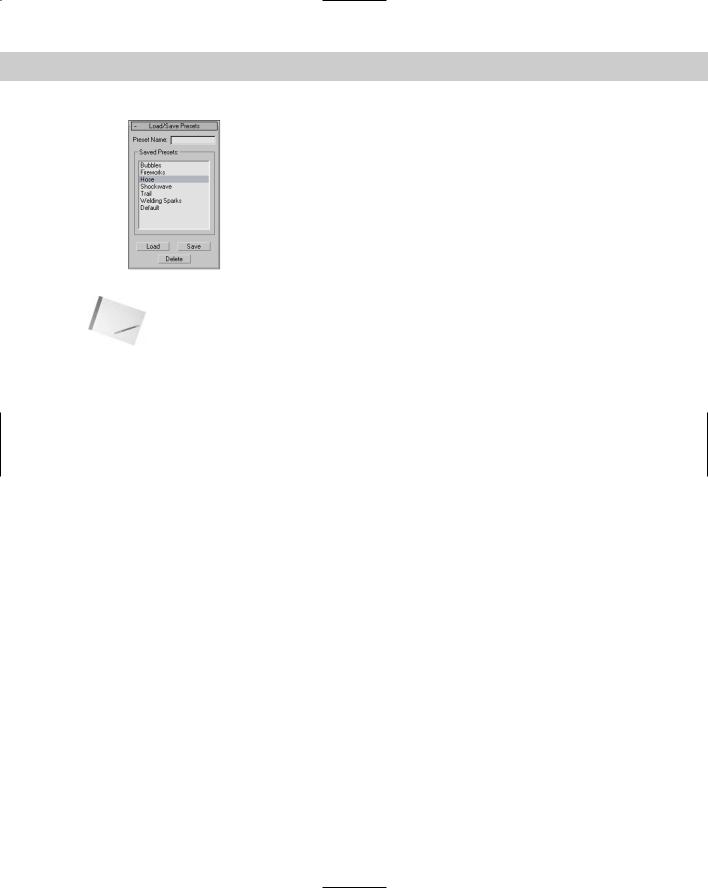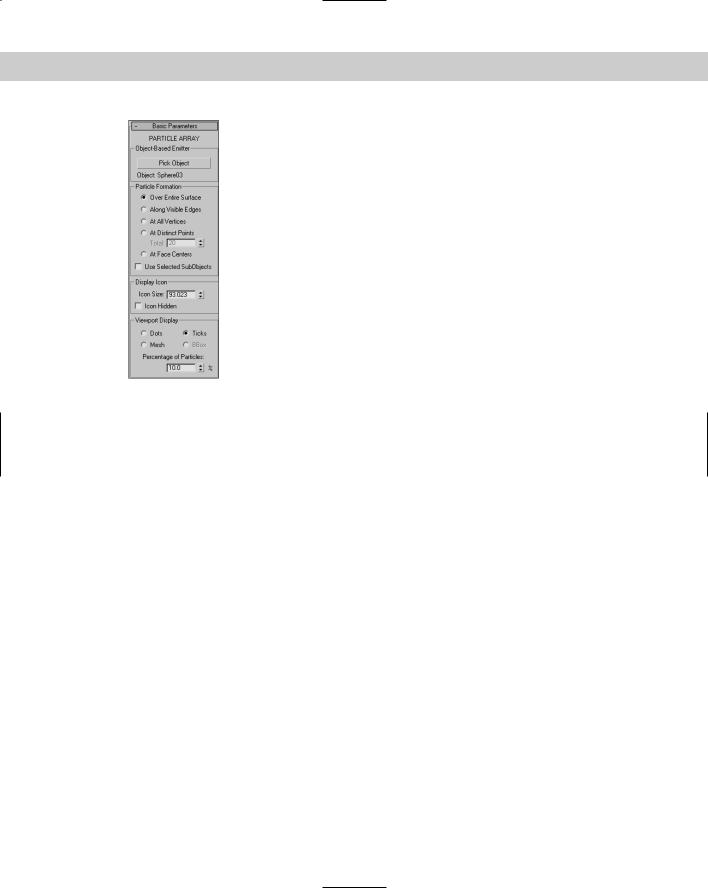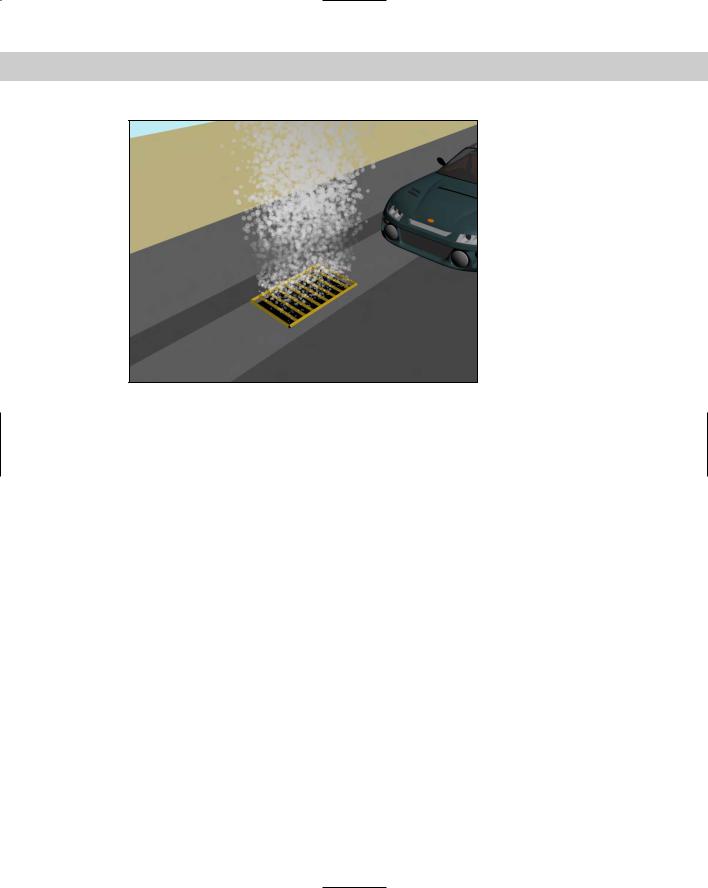
- •Preface
- •About This Book
- •Acknowledgments
- •Contents at a Glance
- •Contents
- •Relaxing at the Beach
- •Dressing the Scene
- •Animating Motion
- •Rendering the Final Animation
- •Summary
- •The Interface Elements
- •Using the Menus
- •Using the Toolbars
- •Using the Viewports
- •Using the Command Panel
- •Using the Lower Interface Bar Controls
- •Interacting with the Interface
- •Getting Help
- •Summary
- •Understanding 3D Space
- •Using the Viewport Navigation Controls
- •Configuring the Viewports
- •Working with Viewport Backgrounds
- •Summary
- •Working with Max Scene Files
- •Setting File Preferences
- •Importing and Exporting
- •Referencing External Objects
- •Using the File Utilities
- •Accessing File Information
- •Summary
- •Customizing Modify and Utility Panel Buttons
- •Working with Custom Interfaces
- •Configuring Paths
- •Selecting System Units
- •Setting Preferences
- •Summary
- •Creating Primitive Objects
- •Exploring the Primitive Object Types
- •Summary
- •Selecting Objects
- •Setting Object Properties
- •Hiding and Freezing Objects
- •Using Layers
- •Summary
- •Cloning Objects
- •Understanding Cloning Options
- •Mirroring Objects
- •Cloning over Time
- •Spacing Cloned Objects
- •Creating Arrays of Objects
- •Summary
- •Working with Groups
- •Building Assemblies
- •Building Links between Objects
- •Displaying Links and Hierarchies
- •Working with Linked Objects
- •Summary
- •Using the Schematic View Window
- •Working with Hierarchies
- •Setting Schematic View Preferences
- •Using List Views
- •Summary
- •Working with the Transformation Tools
- •Using Pivot Points
- •Using the Align Commands
- •Using Grids
- •Using Snap Options
- •Summary
- •Exploring the Modifier Stack
- •Exploring Modifier Types
- •Summary
- •Exploring the Modeling Types
- •Working with Subobjects
- •Modeling Helpers
- •Summary
- •Drawing in 2D
- •Editing Splines
- •Using Spline Modifiers
- •Summary
- •Creating Editable Mesh and Poly Objects
- •Editing Mesh Objects
- •Editing Poly Objects
- •Using Mesh Editing Modifiers
- •Summary
- •Introducing Patch Grids
- •Editing Patches
- •Using Modifiers on Patch Objects
- •Summary
- •Creating NURBS Curves and Surfaces
- •Editing NURBS
- •Working with NURBS
- •Summary
- •Morphing Objects
- •Creating Conform Objects
- •Creating a ShapeMerge Object
- •Creating a Terrain Object
- •Using the Mesher Object
- •Working with BlobMesh Objects
- •Creating a Scatter Object
- •Creating Connect Objects
- •Modeling with Boolean Objects
- •Creating a Loft Object
- •Summary
- •Understanding the Various Particle Systems
- •Creating a Particle System
- •Using the Spray and Snow Particle Systems
- •Using the Super Spray Particle System
- •Using the Blizzard Particle System
- •Using the PArray Particle System
- •Using the PCloud Particle System
- •Using Particle System Maps
- •Controlling Particles with Particle Flow
- •Summary
- •Understanding Material Properties
- •Working with the Material Editor
- •Using the Material/Map Browser
- •Using the Material/Map Navigator
- •Summary
- •Using the Standard Material
- •Using Shading Types
- •Accessing Other Parameters
- •Using External Tools
- •Summary
- •Using Compound Materials
- •Using Raytrace Materials
- •Using the Matte/Shadow Material
- •Using the DirectX 9 Shader
- •Applying Multiple Materials
- •Material Modifiers
- •Summary
- •Understanding Maps
- •Understanding Material Map Types
- •Using the Maps Rollout
- •Using the Map Path Utility
- •Using Map Instances
- •Summary
- •Mapping Modifiers
- •Using the Unwrap UVW modifier
- •Summary
- •Working with Cameras
- •Setting Camera Parameters
- •Summary
- •Using the Camera Tracker Utility
- •Summary
- •Using Multi-Pass Cameras
- •Creating Multi-Pass Camera Effects
- •Summary
- •Understanding the Basics of Lighting
- •Getting to Know the Light Types
- •Creating and Positioning Light Objects
- •Viewing a Scene from a Light
- •Altering Light Parameters
- •Working with Photometric Lights
- •Using the Sunlight and Daylight Systems
- •Using Volume Lights
- •Summary
- •Selecting Advanced Lighting
- •Using Local Advanced Lighting Settings
- •Tutorial: Excluding objects from light tracing
- •Summary
- •Understanding Radiosity
- •Using Local and Global Advanced Lighting Settings
- •Working with Advanced Lighting Materials
- •Using Lighting Analysis
- •Summary
- •Using the Time Controls
- •Working with Keys
- •Using the Track Bar
- •Viewing and Editing Key Values
- •Using the Motion Panel
- •Using Ghosting
- •Animating Objects
- •Working with Previews
- •Wiring Parameters
- •Animation Modifiers
- •Summary
- •Understanding Controller Types
- •Assigning Controllers
- •Setting Default Controllers
- •Examining the Various Controllers
- •Summary
- •Working with Expressions in Spinners
- •Understanding the Expression Controller Interface
- •Understanding Expression Elements
- •Using Expression Controllers
- •Summary
- •Learning the Track View Interface
- •Working with Keys
- •Editing Time
- •Editing Curves
- •Filtering Tracks
- •Working with Controllers
- •Synchronizing to a Sound Track
- •Summary
- •Understanding Your Character
- •Building Bodies
- •Summary
- •Building a Bones System
- •Using the Bone Tools
- •Using the Skin Modifier
- •Summary
- •Creating Characters
- •Working with Characters
- •Using Character Animation Techniques
- •Summary
- •Forward versus Inverse Kinematics
- •Creating an Inverse Kinematics System
- •Using the Various Inverse Kinematics Methods
- •Summary
- •Creating and Binding Space Warps
- •Understanding Space Warp Types
- •Combining Particle Systems with Space Warps
- •Summary
- •Understanding Dynamics
- •Using Dynamic Objects
- •Defining Dynamic Material Properties
- •Using Dynamic Space Warps
- •Using the Dynamics Utility
- •Using the Flex Modifier
- •Summary
- •Using reactor
- •Using reactor Collections
- •Creating reactor Objects
- •Calculating and Previewing a Simulation
- •Constraining Objects
- •reactor Troubleshooting
- •Summary
- •Understanding the Max Renderers
- •Previewing with ActiveShade
- •Render Parameters
- •Rendering Preferences
- •Creating VUE Files
- •Using the Rendered Frame Window
- •Using the RAM Player
- •Reviewing the Render Types
- •Using Command-Line Rendering
- •Creating Panoramic Images
- •Getting Printer Help
- •Creating an Environment
- •Summary
- •Creating Atmospheric Effects
- •Using the Fire Effect
- •Using the Fog Effect
- •Summary
- •Using Render Elements
- •Adding Render Effects
- •Creating Lens Effects
- •Using Other Render Effects
- •Summary
- •Using Raytrace Materials
- •Using a Raytrace Map
- •Enabling mental ray
- •Summary
- •Understanding Network Rendering
- •Network Requirements
- •Setting up a Network Rendering System
- •Starting the Network Rendering System
- •Configuring the Network Manager and Servers
- •Logging Errors
- •Using the Monitor
- •Setting up Batch Rendering
- •Summary
- •Compositing with Photoshop
- •Video Editing with Premiere
- •Video Compositing with After Effects
- •Introducing Combustion
- •Using Other Compositing Solutions
- •Summary
- •Completing Post-Production with the Video Post Interface
- •Working with Sequences
- •Adding and Editing Events
- •Working with Ranges
- •Working with Lens Effects Filters
- •Summary
- •What Is MAXScript?
- •MAXScript Tools
- •Setting MAXScript Preferences
- •Types of Scripts
- •Writing Your Own MAXScripts
- •Learning the Visual MAXScript Editor Interface
- •Laying Out a Rollout
- •Summary
- •Working with Plug-Ins
- •Locating Plug-Ins
- •Summary
- •Low-Res Modeling
- •Using Channels
- •Using Vertex Colors
- •Rendering to a Texture
- •Summary
- •Max and Architecture
- •Using AEC Objects
- •Using Architectural materials
- •Summary
- •Tutorial: Creating Icy Geometry with BlobMesh
- •Tutorial: Using Caustic Photons to Create a Disco Ball
- •Summary
- •mental ray Rendering System
- •Particle Flow
- •reactor 2.0
- •Schematic View
- •BlobMesh
- •Spline and Patch Features
- •Import and Export
- •Shell Modifier
- •Vertex Paint and Channel Info
- •Architectural Primitives and Materials
- •Minor Improvements
- •Choosing an Operating System
- •Hardware Requirements
- •Installing 3ds max 6
- •Authorizing the Software
- •Setting the Display Driver
- •Updating Max
- •Moving Max to Another Computer
- •Using Keyboard Shortcuts
- •Using the Hotkey Map
- •Main Interface Shortcuts
- •Dialog Box Shortcuts
- •Miscellaneous Shortcuts
- •System Requirements
- •Using the CDs with Windows
- •What’s on the CDs
- •Troubleshooting
- •Index

Chapter 18 Creating Particles and Particle Flow |
529 |
Figure 18-15: The Load/Save Presets rollout enables you to save different parameter settings.
Note A saved preset is valid only for the type of particle system used to save it. For example, you cannot save a Super Spray preset and load it for a Blizzard system.
Max includes several default presets that can be used as you get started. These presets include Bubbles, Fireworks, Hose, Shockwave, Trail, Welding Sparks, and Default (which produces a straight line of particles).
Using the Blizzard Particle System
The Blizzard particle system uses the same rollouts as the Super Spray system, with some slightly different options. The Blizzard emitter icon is a plane with a line pointing in the direction of the particles (similar to the Spray and Snow particle systems). Particles are emitted across the entire plane surface.
The differences between the Blizzard and Super Spray parameters include dimensions for the Blizzard icon. In the Particle Generation rollout, you’ll find values for Tumble and Tumble Rate. Another difference is the Emitter Fit Planar option under the Material Mapping group of the Particle Type rollout. This option sets particles to be mapped at birth, depending on where they appear on the emitter. The other big difference is that the Blizzard particle system has no Bubble Motion rollout, because snowflakes don’t make very good bubbles. Finally, you’ll find a different set of presets in the Load/Save Presets rollout, including Blizzard, Rain, Mist, and Snowfall.
Using the PArray Particle System
The PArray particle system is a unique particle system. It emits particles from the surface of a selected object. These particles can be emitted from the object’s surface, edges, or vertices. The particles are emitted from an object separate from the emitter icon.
The PArray particle system includes many of the same rollouts as the Super Spray particle system. The PArray particle system’s emitter icon is a cube with three tetrahedron objects inside it. This system has some interesting parameter differences, starting with the Basic Parameters rollout, shown in Figure 18-16.

530 Part III Modeling
Figure 18-16: The Basic Parameters rollout for the PArray particle system lets you select the location where the particles form.
In the PArray system, you can select separate objects as emitters with the Pick Object button. You can also select the location on the object where the particles are formed. Options include Over Entire Surface, Along Visible Edges, At All Vertices, At Distinct Points, and At Face Centers. For the At Distinct Points option, you can select the number of points to use.
The Use Selected Sub-Object option forms particles in the locations selected with the Pick Object button, but only within the subobject selection passed up the Stack. This is useful if you want to emit particles only from a certain selection of a mesh, such as a dragon’s mouth or the end of a fire hose. The other options in the PArray system’s Basic Parameters rollout are the same as in the other systems.
The Particle Generation rollout includes a Divergence value. This value is the angular variation of the velocity of each particle from the emitter’s normal.
Splitting an object into fragments
The Particle Type rollout for the PArray system contains a unique particle type: Object Fragments. This type breaks the selected object into several fragments. Object Fragment settings include a Thickness value. This value gives each fragment a depth. If the value is set to 0, the fragments are all single-sided polygons.

Chapter 18 Creating Particles and Particle Flow |
531 |
Also in the Particle Type rollout, the All Faces option separates each individual triangular face into a separate fragment. An alternative to this option is to use the Number of Chunks option, which enables you to divide the object into chunks and define how many chunks to use. A third option splits up an object based on the smoothing angle, which can be specified.
In the Material section of the Particle Type rollout, you can select material IDs to use for the fragment’s inside, outside, and backside.
The Load/Save Presets rollout includes a host of interesting presets, including the likes of Blast, Disintegrate, Geyser, and Comet.
Tutorial: Creating rising steam
In this tutorial, we create the effect of steam rising from a street vent. Using the PArray particle system, you can control the precise location of the steam.
To create the effect of steam rising from a vent, follow these steps:
1.Open the Street vent.max file from the Chap 18 directory on the CD-ROM.
This file includes a street scene with a vent. The car model was created by Viewpoint Datalabs.
2.Select the Create Particles PArray menu command, and drag in the Front viewport to create the system.
3.In the Basic Parameters rollout, click the Pick Object button and select the Plane object that is positioned directly beneath the vent object. Set the Particle Formation option to Over Entire Surface Because the Plane object only has a single face, the particles travel in the direction of the Plane’s normal.
4.In the Particle Generation rollout, set the Emit Stop value to 100, the Life value to 60 with a Variation of 50. Set the Particle Size value to 5.0 with a Variation of 30.
5.In the Particle Type rollout, select the Standard Particles and the Constant options.
6.Open the Material Editor (by selecting the M key) and name the selected sample slot steam. Click the map button to the right of the Opacity value and double-click the Mask map type from the Material/Map Browser. In the Mask Parameters rollout, click the Map button and select the Noise map type. Then click the Go to Parent button to return to the Mask map, click the Mask button, and select the Gradient map type. For the Gradient material, drag the black color swatch to the white color swatch, select Swap in the dialog box that appears, and enable the Radial option. Finally, drag the steam material to the PArray icon.
Figure 18-17 shows the steam vent at frame 60.

532 Part III Modeling
Figure 18-17: A Plane object positioned beneath the vent is an emitter for the particle system.
Using the PCloud Particle System
The PCloud particle system keeps all emitted particles within a selected volume. This volume can be a box, sphere, cylinder, or a selected object. The emitter icon is shaped as the selected volume. This particle system includes the same rollouts as the Super Spray system with some subtle differences.
The options on the Basic Parameters rollout are unique to this system. This system can use a separate mesh object as an emitter. To select this emitter object, click the Pick Object button and select the object to use. Other options include Box, Sphere, and Cylinder Emitter. For these emitters, the Rad/Len, Width, and Height values are active for defining its dimensions.
In addition to these differences in the Basic Parameters rollout, several Particle Motion options in the Particle Generation rollout are different for the PCloud system as well. Particle Motion can be set to either a random direction, a specified vector, or in the direction of a reference object’s Z axis.
The only two presets for this particle system in the Load/Save Presets rollout are Cloud/Smoke and Default.
Using Particle System Maps
Using material maps on particles is another way to add detail to a particle system without increasing its geometric complexity. You can apply all materials and maps available in the Material Editor to particle systems. To apply them, select the particle system icon and click the Assign Material to Selection button in the Material Editor.

Chapter 18 Creating Particles and Particle Flow |
533 |
Cross- |
For more details on using maps, see Chapter 22, “Adding Material Details with Maps.” |
Reference |
|
Two map types are specifically designed to work with particle systems: Particle Age and Particle MBlur. You can find these maps in the Material/Map Browser. You can access the Material/Map Browser using the Rendering Material Map Browser menu command or from the Material Editor by clicking on the Get Material button.
Using the Particle Age map
The Particle Age map parameters include three different colors that can be applied at different times, depending on the Life value of the particles. Each color includes a color swatch, a map button, an Enable check box, and an Age value for when this color should appear.
This map typically is applied as a Diffuse map because it affects the color.
Using the Particle MBlur map
The Particle MBlur map changes the opacity of the front and back of a particle, depending on the color values and sharpness specified in its parameters rollout. This results in an effect of blurred motion if applied as an Opacity map.
Note |
MBlur does not work with the Constant, Facing, MetaParticles, or PArray object fragments. |
Tutorial: Creating jet engine flames
The Particle Age and MBlur maps work well for adding opacity and colors that change over time, such as hot jets of flames, to a particle system.
To create jet engine flames, follow these steps:
1.Open the Jet airplane flames.max file from the Chap 18 directory on the CD-ROM. This file includes an A-10 airplane model created by Viewpoint Datalabs.
2.Select the Create Particles Super Spray menu command, and drag the icon in the viewport. Rotate and position the emitter icon so that its origin is right in the jet’s exhaust port and the directional vector is pointing outward away from the jet.
3.Open the Modify panel, and in the Basic Parameters rollout, set the Off Axis Spread value to 20 and the Off Plane Spread value to 90; these settings focus the flames shooting from the jet’s exhaust.
4.In the Particle Generation rollout, set the Emit Stop to 100, the Life value to 30, and the Particle Size to 5.0.
5.In the Particle Type rollout, select the Standard Particles option and select the Sphere type.
6.Open the Material Editor by pressing the M key, and select the first sample slot. Name this material Jet’s Exhaust, and click the map button to the right of the Diffuse color.
